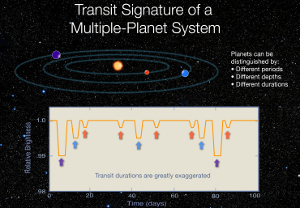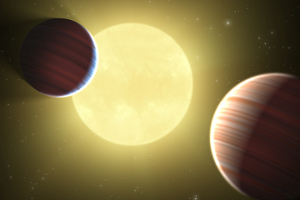In 1995, a Swiss team found the first exoplanet passing in front of a star. Since then, there have been nearly 500 exoplanets discovered, though most of these have been large, Jupiter-sized planets that wouldn’t be capable of supporting life.
These large exoplanets were found with ground-based telescopes but now missions like Kepler and the European Space Agency’s COROT mission, which launched in December 2006, add an additional tool for exoplanet discovery with space-based telescopes that are powerful enough and presumably close enough to detect smaller, Earth-sized exoplanets.
“Mankind has been asking the question, ‘are there other planets out there, is there other life out there?’”, said Borucki. “In the next few years, we'll have answers to some of these questions.”
To help answer these questions, the Kepler spacecraft telescope is positioned 18 million miles from Earth, staring at hundreds of billions of stars. It can view more than 100,000 stars at a time that are a few hundred to a few thousand light years from the sun. A light year is roughly 6 trillion miles.
The telescope instrument is more than three feet wide, armed with an array of light sensor detectors akin to those found in a digital camera, only more powerful. But instead of taking pictures of a star, it measures the temporary dips in brightness from a star when a planet transits, or passes in front of the star.
By measuring these dips, how often they occur and how long it takes the planet to transit the star, scientists can confirm the existence of an exoplanet and how far it is from its star. By adding Kepler’s measurements to ground-based telescopes measuring the properties of stars, they can calculate the planet’s temperature, its mass and they can even infer the composition of the planet– whether it contains a rocky core or is mostly gas, for example.
 Transit signature of a multi-planet system (credit: NASA)
Transit signature of a multi-planet system (credit: NASA)
Scientists said that it’s too soon to definitively confirm the existence of a third possible planet – about 1.5 times the radius of Earth – orbiting the Kepler-9 star. If it is confirmed, it would be the smallest exoplanet found to date transiting a star.
But this small planet would still be too hot to exist in the ‘habitable zone’ where water and possibly life could exist, given its close, 1.6 day orbit around its star. Similarly, the surfaces of the two confirmed gas giant exoplanets are estimated to be more than 2300 degrees Fahrenheit.
Still, by studying the orbits of the new exoplanets, scientists hope to uncover additional information, such as the formation and migration of planets as they gravitationally pull and tug at each other when orbiting the same star.
In June, the Kepler team announced they had identified more than 700 “candidate” exoplanets after the first 43 days of data collection, including six candidate planetary systems that appeared to contain more than one transiting planet in them.
But the challenge scientists have when identifying smaller exoplanets that transit in an orbit similar to Earth is that such transits occur only about once a year, compared to the more frequent, shorter transits associated generally with hotter, larger planets. So they need a sequence of four transits, typically, to get enough reliable data to confirm the existence of Earth-size planets, which is why the Kepler mission was designed to run for nearly four years.
Scientists are already looking ahead to future missions which may be able to expand upon Kepler’s discoveries.
“There are missions on the planning board that may be able to tell us what the atmospheres are like around these planets, do they have water in them, do they have C02 in them like our Earth’s atmosphere, do they have oxygen?”, Borucki said.
37.52119957659491 -122.0086669921875
 Artist's rendering of exoplanets around a star. (credit: NASA)
Artist's rendering of exoplanets around a star. (credit: NASA)
